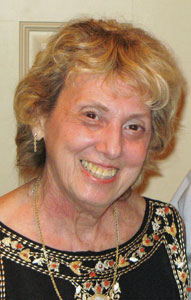 Jerusalem — All week we had been watching with horror the scenes on television and reading about the Carmel fire in the newspapers, the 10,465 acres destroyed and 43 victims.
Jerusalem — All week we had been watching with horror the scenes on television and reading about the Carmel fire in the newspapers, the 10,465 acres destroyed and 43 victims.
When the Jewish National Fund (Keren Kayemet l’Yisael, see box at right) invited foreign correspondents to tour the Carmel with the professional foresters of KKL-JNF to learn about the fire damages and rehabilitation plans, we were eager to go.
In a few short hours, we were following the giant leaps the fire had taken a few days before. The smell was in my nostrils, the black embers were under my tennis shoes and the puffs of smoke were still smoldering in a few places by a house in Kibbutz Bet Oren and in the Carmel Forest, four days after the Carmel fire was declared suppressed.
Standing first at an observation point below Haifa University, where the main command post had been established, Israel Tauber, director of forest management for the KKL-JNF, told us this was the worst wild fire ever experienced in Israel in terms of "intensity, size and casualties."
Michael Weinberger, director of the supervisor’s office of forests in the Western Galilee, told us how he saw the mushroom over the Druze village of Isafiya, at approximately 11:30 a.m. on Thursday, Dec. 2, and decided to bring on the northern region fire crews and the duster airplane, feeling "this would be a huge fire," since it seemed to be running a mile per hour. One hundred and twenty men and 12 fire engines, 70 percent of the country’s forces, were called up to assist what seemed to be man-made, probably due to neglect, which had started at Isafiya.
Kalil Adar, director of the forest department for the northern region of JNF, showed us maps, as we stood 1700 feet above sea level, pointing out how the fire appeared on the peaks of the ridge then to the west and northwest. The strong, dry eastern winds, low humidity and lack of rain for the past eight months contributed to the intensity. «I›ve never seen such a situation regarding intensity and crazy behavior,» said Adar. Seeing the black hills made the fire even more real to us.
Our next stop was Kibbutz Bet Oren. In 1934 the kibbutz was settled as part of a watch tower and stockade camp then after an Arab attack two years later, it was abandoned, only to be refounded in 1939. In 1999, members petitioned the High Court of Justice to classify it as a cooperative society, and today it has gone privatized and is a community village. It operates a hotel and spa, horse riding center, lead factory, glass work shop, membership-based swimming pool, a pub with live bands and a mountain-bike store offering bikes, repairs and guided trips.
We climb a hill and meet Yohay Cohen, born on the kibbutz and now co-owner of the spa attached to the hotel. Yohay explained that although the village had created an emergency team several months ago, they had no special uniform or identification to show to those who were part of the official fire-fighting crews, so when they received a call at 11:30 calling for evacuation, buses came first to remove the children and the elderly. The rest of the people were also evacuated, leaving only the emergency team. The Haifa Police Chief Deputy Commander, Ahuva Tomer, then came and told them to evacuate.
She continued to the road, across the valley, where the bus of prison service cadets was traveling. It was consumed by fire and she too was fatally burned in her car, while following the bus.
Yohay relates how he stood on the road of the kibbutz, looking across the wadi 600-700 meters in the distance. He could see the bus coming on the road as it hit the fire. «I asked myself, who would send a bus of people into the fire?"
On the kibbutz, Yohay explained how "the fire came down the mountain, its fumes were very strong, it went past the road and burned the [kibbutz] night club." It continued on, consuming 15 buildings containing 40 apartments.
He walked us down the road, past the yellow ribbons, further into the kibbutz. We were shocked to see the burned-out apartment buildings where smoke is still smoldering. Right off the path there was a pile of burned objects taken from the destroyed apartments. I was so touched by toys, a doll, a bath tub. Further on were two burned-out skeletons of cars. The kibbutz was unable to get water to the burning areas because the water pumps were electrically controlled and the electricity had been interrupted, he told us.
In one burned-out building they found a room, unknown to the kibbutz, where the Haganah had stored weapons, prior to 1948.
Kalil Adar, director of the forest department for the Northern Region of KKL-JNF, explained how the falling missiles in the 2006 Second Lebanon War created fires, "but we confronted the fires. You didn’t see the enemy; you didn’t know when the next missile would fall and for the first time, we had the feeling we might die because of the missiles falling. As commander of the crews, I can tell you, the people were very brave and very strong."
Michael Weinberger, director of the supervisor’s office of forests in the Western Galilee, says that since those fires, 20 fire trucks were purchased but without the planes sent in to help this time, the damage would have doubled from this fire.
We board the van, drive down the hill and out of the kibbutz and then across the wadi to the road to drive past the site of the bus burning. There is bumper to bumper traffic with people stopping to gaze at or add to a memorial by laying flowers and candles at this location. It is so unreal to be where this happened.
From here, we drive up to the Carmel forest across the road from the luxury Carmel Spa resort. The smell is strong as we stand among the burned embers. We hear how the area was engulfed in smoke last Friday night and they saw the fire coming toward the hotel. This is one of the only spots where you could get to the fire from fire engines.
In this mixed forest with pine trees and oaks, we learn how rehabilitation of the forests will take place. They hope the area will have pine seedlings in three to four months and the natural oaks will grow on their own. Every section will be planned because the area is sensitive and the issue is sensitive, but it may be 30-40 years before there is a forest. In the meantime, people will not be allowed to walk in the area while the young seedlings take root.
Dr. Omri Boneh, director of the KKL Northern Region and with KKL for 28 years, speaks to us while we stop for lunch in a picnic area. Trails, picnic areas and sites, located in the burned areas, will need to be rehabilitated. On a happier note, all of the animals in the nearby Hai Bar wild life refuge were saved.
Israel Tauber, director of forest management for the KKL-JNF, tell us "there were no forests or vegetation before the state was established. Bringing back the forests was a kind of national goal."
Kalil Adar, director of the forest department for the Northern Region of KKL-JNF adds that, "to the KKL crews, the forest is our day-to-day life. A few battles were won but not the whole war."
About KKL-JNF
Keren Kayemet l’Yisrael



